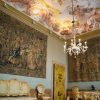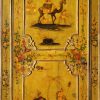The ceiling of this room is decorated with a complex allegorical painting also done in the winter of 1757/58 by Jacopo Guarana, one of the most prolific fresco painters in the Venetian palaces, who carried on Tiepolo’s work after this artist’s departure for Spain. In the composition we can recognize Fortitude with the helmet, and Temperance; then, higher up, Marital Harmony and Valour with the lion. On the left are Justice and Prudence; higher up Eternity with the sun and moon, Abundance, and Glory. In the corners are the theological Virtues.
The rich decorative frescoed cornice surrounding the central scene is the work of the quadratura or architectural trompe-l’oeil painter Piero Visconti, who collaborated with Guarana in other circumstances too. Guarana, who here was just beginning his career, immediately revealed a stylistic and cultural orientation which were very different from Tiepolo’s. He abandoned bold perspectives, presenting a composition which stretched over a single visual plane, the figures being arranged in coy poses and described with careful, meticulous brushstrokes. Guarana’s colour scheme consists of delicate half-tones, very different from his master’s dazzling palette.
The room takes its name from three 18th-century Flemish wall-tapestries with scenes from the story of Solomon and the Queen of Sheba. Like the magnificent furniture in this room, the tapestries come from palazzo Balbi Valier at Santa Maria Formosa. The refined workmanship of the tables with their green marble tops, the armchairs, the rare three-seater sofa, the two gheridòns (or three-legged tables), the curtainholders (called buonegrazie in Venetian), make this one of the most remarkable suites of furniture in the Venetian Rococo style to have survived intact. The sinuosity of the legs of the furniture, and the delicate ornamentation of the surfaces, which imitates the asymmetries of sea foam and broken shells, are typical of mid-18th century late Rococo; they also demonstrate the change in taste as compared with the furniture made by Brustolon fifty years previously, as regards both form and materials.
In this room we find the sole surviving element of the original furnishings, that is to say the lacquered door decorated with oriental patterns, a testimony to the great 18th-century passion for chinoiserie. This very rare example is datable around 1760; some scholars have suggested that it may have been based on drawings by Giambattista or Giandomenico Tiepolo, at the time working on the frescoes of the palace’s rooms.
On the shorter walls, above the two chest of drawers, two wooden sculptures by Andrea Brustolon representing the Penitent Magdalene and the Equestrian Statue of Marcus Aurelius, are displayed.

